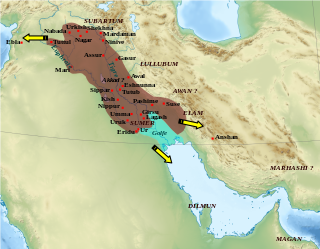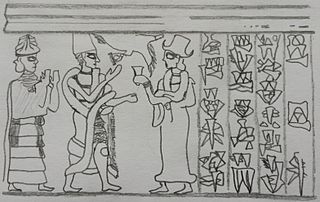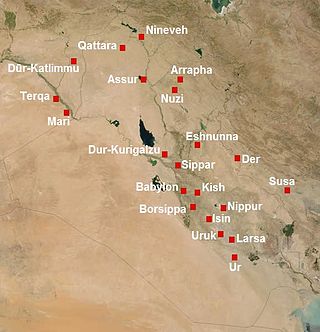| Location | Iraq |
|---|---|
| Region | Mesopotamia |
Diniktum, inscribed Di-ni-ik-tumKI, was a still unlocated middle bronze-age town often thought to be located somewhere in the Diyala Governorate of Iraq. [1]
| Location | Iraq |
|---|---|
| Region | Mesopotamia |
Diniktum, inscribed Di-ni-ik-tumKI, was a still unlocated middle bronze-age town often thought to be located somewhere in the Diyala Governorate of Iraq. [1]
It enjoyed independence briefly during the 18th century under the reigns of the Amorite chieftains (ra-bí-an MAR.DÚ) Itur-šarrum, [2] attested on a single seal from Ešnunna, and Sîn-gāmil, son of Sîn-šēmi and a contemporary of Zimri-Lim (ca. 1710–1698 BC short) of Mari and Ḫammu-rapī (ca. 1728–1686 BC short) of Babylon, attested in a brick inscription "Sin-gamil, Amorite chief of Diniktum, son of Sin-semi.". [1] In an old Babylonian letter from Yarim-Lim I, the king of Yamḫad to the Yašub-Yahad, the king of Dēr, [3] [4] [5] he says:
.. Certainly. Sîn-gāmil, king of Diniktum. very much like you would repeatedly respond to me by means of lies and provocations. Having docked 500 boats in Diniktum's quay. I "sank" (supported?) his land as well as him for 12 year!" [6]
— Iarīm-Līm, Tablet A. 1314, Letter to Yašub-Yahad
Yarim-Lim I would defeat the king of Diniktum in battle. [7]
One king of Diniktum named Itur-šarrum ruled Diniktum for around a century before his successor Sîn-gāmil became the new ruler of the kingdom. [8]
Ikūn-pî-Sîn (“The word of Sin is truthful”), the ruler of Nērebtum (Tell Ishchali) and possibly Tutub, cities in the sphere of Ešnunna, has a year name: “Year when Ikū(n)-pî-Sîn captured Diniktum." [9] [10] It was absorbed into the kingdom of Ešnunna and consequently embroiled in its conflicts with Elam during the reigns of Ibāl-pî-El II (ca. 1715–1701 BC short) and Ṣillī-Sîn (ca. 1700–1698 BC short). [11] During an Elamite invasion of Mesopotamia the Elamites sacked Eshnunna. This caused many soldiers in the Elamite army that were from Eshnunna to defect. Because of the mass desertion, the Elamite king retreated back to Diniktum. While in Diniktum, the Elamites would sue for peace with Hammurabi. The Elamites were then driven from the city. [12]
The town was still settled in the later bronze-age, as a year name of 15th century BC Kassite ruler Kadashman-harbe I reads "the year [in which] Kadašman-Ḫarbe, the king, dug the canal of Diniktum". [13] [14]
An early proposal was on the Tigris river downstream from Upi and close to the northern border of Elam. It has also been suggested as being at or in the vicinity of Tell Muhammad, which lies in south-eastern part of modern Baghdad. [15] [2] Diniktum is mentioned in the Harmal geographical list, Tablet IM 51143. [16]
In a survey of archaeological sites in the Diyala region of Iraq a site, Tell #851, was identified as a possible location for Diniktum. It showed surface remains from the Ubaid to Kassite periods. A local resident there turned in six UrIII/Larsa cylinder seals (one mentioned the god Ninib) and an inscribed brick. The brick read "Sîn-gāmil the great leader of Martu of the city Diniktum son of Sin-šemi". [17] [18]

Hammurabi, also spelled Hammurapi, was the sixth Amorite king of the Old Babylonian Empire, reigning from c. 1792 to c. 1750 BC. He was preceded by his father, Sin-Muballit, who abdicated due to failing health. During his reign, he conquered the city-states of Larsa, Eshnunna, and Mari. He ousted Ishme-Dagan I, the king of Assyria, and forced his son Mut-Ashkur to pay tribute, bringing almost all of Mesopotamia under Babylonian rule.

Babylonia was an ancient Akkadian-speaking state and cultural area based in the city of Babylon in central-southern Mesopotamia. It emerged as an Akkadian populated but Amorite-ruled state c. 1894 BC. During the reign of Hammurabi and afterwards, Babylonia was retrospectively called "the country of Akkad", a deliberate archaism in reference to the previous glory of the Akkadian Empire. It was often involved in rivalry with the older ethno-linguistically related state of Assyria in the north of Mesopotamia and Elam to the east in Ancient Iran. Babylonia briefly became the major power in the region after Hammurabi created a short-lived empire, succeeding the earlier Akkadian Empire, Third Dynasty of Ur, and Old Assyrian Empire. The Babylonian Empire rapidly fell apart after the death of Hammurabi and reverted to a small kingdom centered around the city of Babylon.
Sippar was an ancient Near Eastern Sumerian and later Babylonian city on the east bank of the Euphrates river. Its tell is located at the site of modern Tell Abu Habbah near Yusufiyah in Iraq's Baghdad Governorate, some 69 km (43 mi) north of Babylon and 30 km (19 mi) southwest of Baghdad. The city's ancient name, Sippar, could also refer to its sister city, Sippar-Amnanum ; a more specific designation for the city here referred to as Sippar was Sippar-Yaḫrurum (Sippar-Jaḫrurum). The name comes from the Amorite Yaḫrurum tribe that lived in the area along with the Amorite Amnanum tribe. In Sippar was the site where the Babylonian Map of the World was found.

Yamhad (Yamḫad) was an ancient Semitic-speaking kingdom centered on Ḥalab (Aleppo) in Syria. The kingdom emerged at the end of the 19th century BC and was ruled by the Yamhad dynasty, who counted on both military and diplomacy to expand their realm. From the beginning of its establishment, the kingdom withstood the aggressions of its neighbors Mari, Qatna and the Old Assyrian Empire, and was turned into the most powerful Syrian kingdom of its era through the actions of its king Yarim-Lim I. By the middle of the 18th century BC, most of Syria minus the south came under the authority of Yamhad, either as a direct possession or through vassalage, and for nearly a century and a half, Yamhad dominated northern, northwestern and eastern Syria, and had influence over small kingdoms in Mesopotamia at the borders of Elam. The kingdom was eventually destroyed by the Hittites, then annexed by Mitanni in the 16th century BC.

Samsu-iluna was the seventh king of the founding Amorite dynasty of Babylon. His reign is estimated from 1749 BC to 1712 BC, or from 1686 to 1648 BC. He was the son and successor of Hammurabi by an unknown mother. His reign was marked by the violent uprisings of areas conquered by his father and the abandonment of several important cities.

Eshnunna was an ancient Sumerian city and city-state in central Mesopotamia 12.6 miles northwest of Tell Agrab and 15 miles northwest of Tell Ishchali. Although situated in the Diyala Valley northwest of Sumer proper, the city nonetheless belonged securely within the Sumerian cultural milieu. It is sometimes, in archaeological papers, called Ashnunnak or Tuplias.

Der (Sumerian: 𒌷𒂦𒀭𒆠 uruBAD3.ANki; Akkadian: 𒌷𒂦𒀭𒆠 uruBAD3.ANki or 𒌷𒁲𒂊𒊒(𒆠)urude-e-ru(ki)) was a Sumerian city-state at the site of modern Tell Aqar near al-Badra in Iraq's Wasit Governorate. It was east of the Tigris River on the border between Sumer and Elam. At one time it was thought that it might have been ancient Durum (Sumerian: uruBAD3ki) but more recent scholarship has rebutted that.

Ekallatum (Akkadian: 𒌷𒂍𒃲𒈨𒌍, URUE2.GAL.MEŠ, Ekallātum, "the Palaces") was an ancient Amorite city-state and kingdom in upper Mesopotamia.
Khafajah or Khafaje, ancient Tutub, is an archaeological site in Diyala Governorate, Iraq 7 miles (11 km) east of Baghdad. Khafajah lies on the Diyala River, a tributary of the Tigris. Occupied from the Uruk and Jemdet Nasr periods through the end of the Old Babylonian Empire, it was under the control of the Akkadian Empire and then the Third Dynasty of Ur in the 3rd millennium BC. It then became part of the empire of the city-state of Eshnunna lying 12 miles (19 km) southwest of that city, about 5 miles (8.0 km) from the ancient city of Shaduppum, and near Tell Ishchali, both which Eshnunna also controlled. It then fell to Babylonia before falling into disuse.
Shaduppum, modern Tell Harmal, is an archaeological site in Baghdad Governorate (Iraq). Nowadays, it lies within the borders of modern Baghdad about 600 meters from the site of Tell Mohammad. In the Old Babylonian period it was part of the kingdom of Eshnunna. Other cities in the kingdom lie not far away including Eshnunna and Tell Ishchali and Khafajah four and six miles away on the left bank of the Diyala River. The site of Tell al-Dhiba'i, thought to be the ancient town of Uzarzalulu, is about 2 kilometers away and of similar characteristics.

Akkad was the capital of the Akkadian Empire, which was the dominant political force in Mesopotamia during a period of about 150 years in the last third of the 3rd millennium BC.
Yarim-Lim I, also given as Yarimlim, was the second king of the ancient Amorite kingdom of Yamhad in modern-day Aleppo, Syria.
Hammurabi I is the third attested king of Yamhad (Halab).

The Amorites were an ancient Northwest Semitic-speaking Bronze Age people from the Levant. Initially appearing in Sumerian records c. 2500 BC, they expanded and ruled most of the Levant, Mesopotamia and parts of Egypt from the 21st century BC to the late 17th century BC.

The Yamhad dynasty was an ancient Amorite royal family founded in c. 1810 BC by Sumu-Epuh of Yamhad who had his capital in the city of Aleppo. Started as a local dynasty, the family expanded its influence through the actions of its energetic ruler Yarim-Lim I who turned it into the most influential family in the Levant through both diplomatic and military tools. At its height the dynasty controlled most of northern Syria and the modern Turkish province of Hatay with a cadet branch ruling in the city of Alalakh.
Rapiqum, ra-bi-qa-wiKI, was a city of the ancient Near East. The city was located in the north of Mesopotamia, probably on the eastern bank of the Euphrates River, in modern Iraq. It is firmly attested from early in the 2nd Millennium BC until early in the 1st Millennium BC.

Ibal pi’el II was a king of the city kingdom of Eshnunna in ancient Mesopotamia. He reigned c. 1779–1765 BC).
The Isin-Larsa period is a phase in the history of ancient Mesopotamia, which extends between the end of the Third Dynasty of Ur and the conquest of Mesopotamia by King Hammurabi of Babylon leading to the creation of the First Babylonian dynasty. According to the approximate conventional dating, this period begins in 2025 BCE and ended in 1763 BCE. It constitutes the first part of the Old Babylonian period, the second part being the period of domination of the first dynasty of Babylon, which ends with the Sack of Babylon in 1595 BCE and the rise of the Kassites.

The Middle Babylonian period, also known as the Kassite period, in southern Mesopotamia is dated from c. 1595 – c. 1155 BC and began after the Hittites sacked the city of Babylon. The Kassites, whose dynasty is synonymous with the period, eventually assumed political control over the region and consolidated their power by subjugating the Sealand dynasty c. 1475 BC. After the subjugation of the Sealand dynasty, the Kassites unified the region of Babylonia into a single political entity. At the height of the Middle Babylonian period, the Kassite kings were engaging in commerce, trade, and organising diplomatic marriages with the kings of Egypt and other regional powers. However, after a period of gradual decline, the Middle Babylonian period collapsed with the fall of the Kassite dynasty c. 1155 BC. The collapse came as a result of an Assyrian invasion, that temporarily displaced the Kassites from their rule over southern Mesopotamia. Finally, the Elamites conducted various raids and eventually invaded Babylonian c. 1158 BC, which brought the Kassite dynasty and Middle Babylonian period to an end.
Tell Muhammad, is an ancient Near East archaeological site currently in the outskirts of Baghdad, along the Tigris river in the Diyala region. It is a very short distance from the site of Tell Harmal to the north and not far from the site of Tell al-Dhiba'i to the northeast. The ancient name of the site is unknown though Diniktum has been suggested. The lost city of Akkad has also been proposed. Based on a year name found on one of the cuneiform tablets the name Banaia has also been proposed.
{{cite book}}: CS1 maint: location missing publisher (link){{cite book}}: CS1 maint: location missing publisher (link)